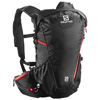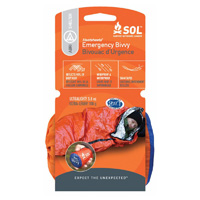What to Bring
Three Peaks Trip
By Ashley Burke
What to Bring Three Peaks Trip By Ashley Burke |
This equipment list is intended for a Blue Mountains Three Peaks in under 48 hours attempt. It is not really intended for any other trip. For more information about the Three Peaks, please see my Three Peaks Page.
Suitability
If the Three Peaks were an official trail run (which it isn't) and if I were its race director (which I'm not) then I would consider the below kit list as mandatory for all participants. This kit list is aimed at keeping weight to an absolute minimum whilst ensuring that you are carrying enough gear to be safe and self sufficient throughout the route, which is wild and untracked for much of its course.
Very importantly, this equipment list assumes that your Three Peaks attempt is in the warmest months of the year - late October to mid-March. Take warmer clothes and a sleeping bag if attempting the Three Peaks outside these months.
Trail runners using this list might notice that the list is similar to the compulsory kit list for the UTA100 (formerly North Face 100) with some key exceptions. First, I delete the whistle (who's going to hear it?) and the safety vest (who's going to see it?) and I also recommend you consider upgrading the space blanket to a bivvy bag. I also stongly urge you to carry a sleeping bag unless you are attempting the Three Peaks in summer or on a weekend where overnight temperatures are guaranteed to be warm. Finally, you must bring enough calories of food to sustain you for at least 40 hours on the move.
On All Three Peaks Trips
These items should be carried on all Three Peaks trips:
| Item | Comments | |
| Backpack (for bushwalkers) or trail runner's hydration pack (for trail runners) | Bushwalkers who intend to camp or sleep en route should take a 30-40 litre backpack, eg: OMM Classic 32L Trail runners would baulk at a pack that size and would prefer their hydration packs. These should have a capacity of at least 15-20 litres for the other essentials in this gear list and food. eg: Salomon Agile 20. |
  |
| Water bottles or hydration system (eg: Camelback) | 2 litres capacity bare minimum. 3 litres in warm dry weather. | |
| Lightweight waterproof jacket with hood | Not a heavy parker, just a lightweight windproof and sprayproof breathable fabric jacket. Some very lightweight models are now on the market. | |
| Powerful LED headlamp | Must be good quality and throw enough light for many hours of nighttime walking. | |
| Spare batteries for headlamp | ||
| Long sleeved thermal top | Woollen thermals are best. eg: ice breaker. | |
| Thermal longjohns | Woollen is best. eg: ice breaker. | |
| Lightweight fleece | ||
| Hat | Not just for sun protection but to protect face from scrub and branches. | |
| Bivvy bag or space blanket | A bivvy bag is like a space blanket but it is a closed bag and not a blanket. Example: Sol Emergency Bivvy that you can get into for protection against the elements. Bivvy bags are also available in heavier and more durable models made from goretex or breathable fabric. This would be more suitable for bushwalkers intending to sleep en route. If you are taking a sleeping bag or inner sheet, then the bivvy bag is an outer waterproof and windproof layer that goes over everything and can substitute for a tent or fly. It can be used without sleeping bag or inner sheet in the warmer months. Alternatives to a bivvy bag include groundsheet plus tent fly, or an ultralightweight tent. For very fit and fast groups attempting a sub 30 hour 3 Peaks without sleep, a normal space blanket is acceptable. |
 |
| Compass | A real one with clear transparent baseplate movable dial, suitable for navigation. See image to right. |  |
| Maps | Kanangra and Jenolan 1:25000 topographic sheets. Those experienced with the route can omit the Jenolan map. You must know the route extremely well to omit maps!!! One set per group is ok. If travelling as a group with one set of maps per group then the group must stay together whenever not on a marked trail! |
|
| Matches or lighter | For lighting a campfire for emergency warmth. | |
| Pocket knife | ||
| Plastic cup or bowl | ||
Personal items:
|
Your first aid kit must, as a minimum, include a compression bandage, band aids, and elastoplast or leukoplast. | |
| Food | Enough calories for at least 40 hours of sustained extreme exercise! See food suggestions below for help on what sort of food to bring. |
|
| Mobile phone | For emergency calls. Faint coverage exists on the summit of each of the Three Peaks but there is little coverage elsewhere on the route. |
Additional Items If Camping Out
If you intend to spend a night sleeping or resting during your Three Peaks attempt, then you should bring the below additional items.
| Item | Comments |
| Sleeping bag | Lightweight 3 season down bag. |
| Sleeping bag liner | Silk liners are the lightest and best. |
| Foam mat or thermarest | |
| Alternative to bivvy bag | Alternatives to a bivvy bag include a groundsheet plus tent fly, or ultralightweight tent. |
| Billy |
Food is a personal matter and everyone will have their own opinions and preferences regarding what food is best to take on a Three Peaks attempt. It also depends a lot on whether you are intending to do it as a bushwalk in 40-48 hours, or as a trail run in 24-30 hours. Those bushwalking and sleeping during the Three Peaks would be well advised to take a billy and matches and cook themselves one hot meal on the trip. A trail runner aiming for a sub 30 hour Three Peaks may choose to do the trip on high energy foods without stopping to cook. One thing is certain though, and that is that no matter how fast you plan on doing your Three Peaks, you must take enough calories with you to sustain you for at least 40 hours on the move. To set out on the Three Peaks without enough calories to last 40 hours is foolish, even if you're asub 30 hour 3 peaker! Always allow enough food for emergencies and unforseen delays.
Here are some food suggestions based on what I would take on a Three Peaks trip. I find that my staple foods on Three Peaks trips are sandwiches, fruit cake, biscuits and energy bars.
Several sandwiches (make up as you go)
Fruit cake
A variety of energy bars
Biscuits
Electrolyte powder (eg: HEED or Tailwind)
Breakfast cereal, 2 serves, with powdered milk
Bananas
Avoid too many simple sugary sweets. Simple sugars should be balanced with complex carbohydrates
If cooking en route:
1 meal of 2 minute noodles with tuna and flavouring
Tea
Web page last updated 16 May 2017
|